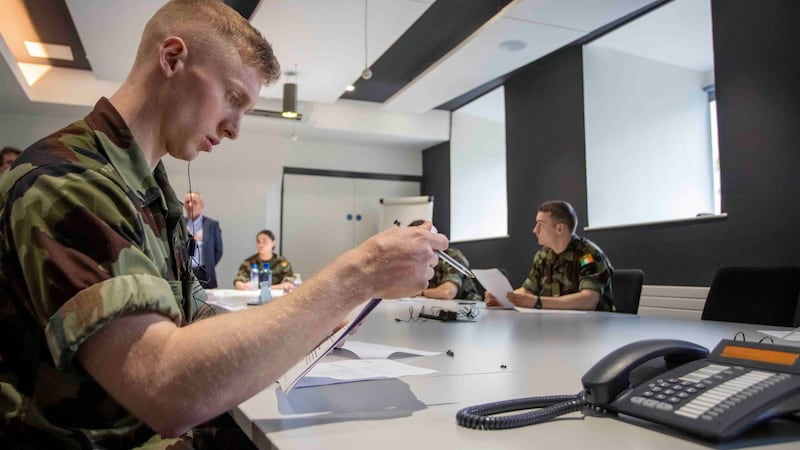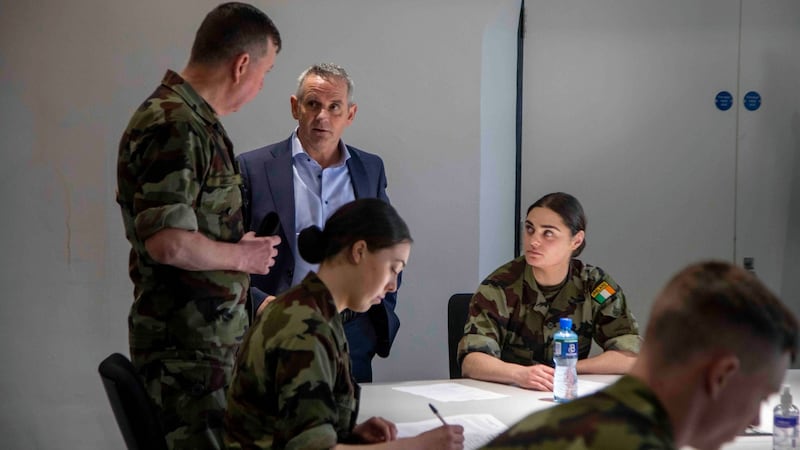Dr Greg Martin uses a resonant phrase when describing the contact tracing programme the HSE has mounted in Ireland to respond to the Covid-19 pandemic. “We are sort of building a plane while we are trying to fly it,” he says as he tries to explain the speed, and scope, and sheer breadth of the operation that has been put in place.
Ireland had its first case of confirmed Covid-19 on February 29th. And at time of writing, more than 6,000 cases have been confirmed in the country. Every one of those 6,000-plus people’s contacts has been contacted. In the beginning, that involved tracing another 40 people or even more. Now, with social distancing, it has become somewhat easier, an average of three per person.
Last Monday and Tuesday, 2,000 phone calls a day were made from the nine contact tracing centres around the country. By next week, it will be geared up to place 5,000 calls a day.
The team responsible for all of this has been scaled up from a few dozen people to a few hundred. It can become a few thousand if the outbreak continues to escalate at pace.
Martin, a public health specialist, refers to the UK where the contact tracing programme was quickly jettisoned on the basis it would be impossible to accomplish.
“Most countries have not even attempted this. Most countries didn’t think of this as something you could do. Ireland has done something that is, in my opinion, quite remarkable, especially given the timeframe within which it’s being done.”
According to his colleague Dr Sarah Doyle, “It was designed, operationalised and implemented within weeks. This is a project that we would ordinarily do over about 18 months and we’re going to do it within weeks.”
Doyle is the clinical lead for the programme. Normally based in Kilkenny, she commutes by train every day to the HSE offices in Dr Steeven’s Hospital next door to Heuston Station. It is here that the contact tracing programme is being run. She, Martin and their colleagues have been putting in 14 hours a day since March in an effort to stay ahead of the curve, by reaching out to people who are at risk of infection at the earliest possible stage. By reaching them, they can hopefully get them to self-isolate immediately.
I've managed lots of outbreaks. This is way beyond every other outbreak
So far, there are 200 people working on the programme but in total 1,700 have received training in how to make the calls. From nine centres around the country, mostly on university campuses but also in the Curragh Defence Forces base in Co Kildare and the offices of the Revenue Commissioners, they place 1,000-2,000 calls a day, depending on how many new cases have been identified.
As public health specialists, Doyle and Martin are well used to infectious diseases and outbreaks, from measles to tuberculosis to serious outbreaks of influenza. “I’ve managed lots of outbreaks. This is way beyond every other outbreak,” says Doyle.
“I find it a very frustrating virus. It’s a conundrum. You know, you really have that sense of it not being measles or tuberculosis or something for which we have years of knowledge behind us.”
Martin adds: “From an epidemiological point of view, it becomes more difficult for us to identify cases. So, if you compare this outbreak to 2003, people who got Sars almost invariably became tremendously ill, so to find those people wasn’t difficult, they were presenting at healthcare facilities because they needed to.
“In the case of Covid-19, there’s a huge cohort who don’t think of themselves as necessarily unwell enough to have Covid-19. And that facilitates the ongoing spread and transmission.”
So how has the contact tracing system been developed to catch what, in many senses, has been a shadow?
Killian McGrane is the HSE lead on the programme and oversees the design and implementation of the scheme. One of his first realisations was that the system was never going to be without flaws, but that acting quickly was vital.
“The line of Dr Mike Ryan from the WHO that you don’t let perfection get in the way of good has been very much our mantra.”
Contact tracing for infectious diseases is not new. What is new is the scale of it, and the complicated logistics involved. The hope is by interrupting the chain of transmission and getting people to self-isolate, it “flattens the curve” of the disease’s spread in the population.
After the first cases were identified in Ireland, plans were implemented to scale up quickly to train in new contact tracers. “So the very first people we had in on Friday the 13th of March were 40 Army cadets,” says McGrane. Their initial task was in the east; all the pressure was there.
“We set the cadets up with their headpieces, and we developed scripts as the programmes evolved.” The team also developed a tracker system to capture demographic and geographical information so clusters could be identified.
It has resulted in more than 60,000 personal contacts and a complex mapping of the State that identifies clusters, demographic information, and lifestyle and travel patterns.
Only a small percentage of diagnoses (about 3 per cent) have been among the under-25s, an indicator of the mild symptoms most of that group experience. Over time, travel restrictions have seen community infection become the dominant source of transmission.

A fundamental of our military training is about becoming <br/> as efficient as possible as quickly as possible

The secondment of the Defence Forces cadets was key. “The strength of the military is we are good at reacting quickly to things,” says Comdt James O’Hara. “A fundamental of our military training is about becoming as efficient as possible as quickly as possible.”
The cadets worked initially from Dr Steeven’s Hospital but have now decamped to the Curragh. Some 20-30 cadets are available there each day, to make phone calls to contacts, and feed the data in to the system.
In another eight centres around the State, teams of public servants do the same thing, reaching thousands of people each day. Two cadet officers are now based in Trinity College Dublin, where they train new people coming in to the programme.
The process is broken down into three phone calls. Everyone who is diagnosed is required to supply a mobile number, which is contacted. In nursing homes and hospital settings, the information gathering is done in conjunction with specialist public health staff, or designated contacts, in situ.
Doyle explains what each call entails: “Call one is done by people who have a clinical background. They tell the person the result is positive, ask them about symptoms and give medical advice.” These people are in a position to make medical decisions if the person is symptomatic.
Call two is made about an hour later. It’s from a contact tracer in one of the centres. They go through a long list of questions and get details of all their contacts, and all of those details are entered into the information system. The person is asked to trawl back through all close contacts for the past fortnight, before they became symptomatic. Close contact is defined as closer than two metres for more than five minutes.
Call three is to all the contacts listed by the person who has a diagnosis. The person is not named and the contacts are asked if they have any symptoms. If they do, they are advised to contact their GP. They are all told to self-isolate for 14 days, irrespective of having symptoms or not. There are always medical personnel on hand in the centres to deal with health issues that might arise.
One of the early diagnoses was a family who came back from a skiing holiday in Italy. As an early case, they had daily contact with contact tracers, who followed up dozens of contacts, because at that stage, no restrictions were in place.
A colleague in The Irish Times, Glen Murphy, was diagnosed in mid March. Within an hour of his diagnosis he got a call from a contact tracer. “I had 40 names and numbers. It included people in Dublin and also at my home place [in Co Kildare].”
Murphy gave numbers for his flatmates, people from whom he had had lifts, a colleague he sat beside in the newsroom. All were contacted that day.
Murphy was even asked about the bus route he used in and out of work, to see if there was potential for transmission there.
As time moved on, the number of cases escalated. However, social distancing quickly led to a reduction of contacts, from an average of 20 down to three (in most cases within the same household).
“When we started on March 10th, our mandate was to to deal with 500 new cases a day,” says McGrane, who says the longer term plan was to scale up to 4,000 a day.
There has been some good news. “We haven’t needed anything like that but that’s the scale of the operation.” Some 1,700 people have been trained, about 200-300 of whom are currently deployed.
But long delays, of up to 14 days, in results for Covid-19 testing has made the situation more challenging. “Contact tracing is less effective in that timeframe,” says Martin. “It’s still important as you are still providing contacts with information. [But] the shorter you can make that time, the better.”
Last week, the National Public Health Emergency Team addressed that big delay by allowing contact tracing for presumptive, as opposed to confirmed, cases.
McGrane says it will lead to a big scaling up of numbers, putting them in a position to deal with 1,000 new cases each day. That’s 5,000 calls or more (1,000 from call one, 1,000 from call two, and an average of 3,000 from call three).
Elsewhere, for example in Singapore and South Korea, smartphone apps have been developed that have mined the users’ movements and phone data to identify potential contacts. That level of invasion would be controversial here. An app is being developed, the functionality of which remains unknown. McGrane believes it could supplement the programme but believes nothing can be more effective than direct human contact.
What they're doing is saving lives by contributing to a <br/> process that is going to reduce the number of people <br/> who get sick in Ireland
“The [phone call] has a very big impact, a bigger impact than the text messages from the feedback we have been getting. It’s somebody’s saying: Listen, you have been confirmed or you are a contact of a confirmed case.”
Doyle and Martin have a message for the “unsung heroes” making those thousands of calls. “What they’re doing is saving lives by contributing to a process that is going to reduce the number of people who get sick in Ireland,” says Martin.
“Whatever this outbreak turns out to be, is going to be less than it would have been without the operation . . . The people whose lives they save will never even know that their lives were saved.”










